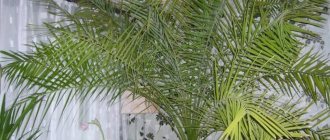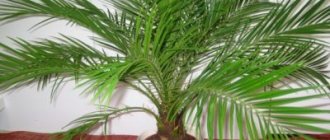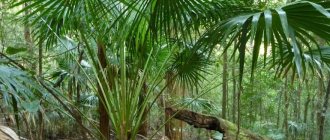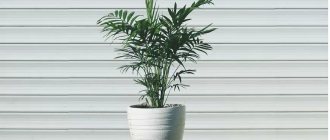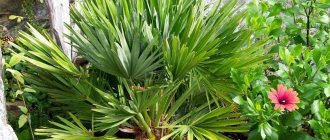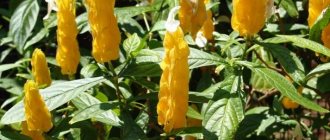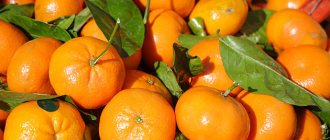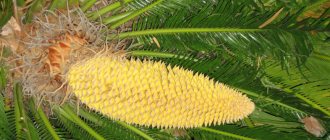Dates, beloved by many, grow on palm trees. Is it possible to grow it at home? Can! This exotic tree looks original and will become a real interior decoration. The date palm will be green and pleasing to the eye all year round. Some species will give luxurious blooms. Let's figure out what type of palm tree to choose for your home, how to grow and care for it.
Types of date palms
The origin of the date palm is uncertain today. It was mentioned by the ancient Phoenicians, Greeks, Jews, and Hindus. She was well known in Egypt and the Middle East. Daughters were named after palm trees in different languages. It was believed that this would bring beauty to the baby, many children and good luck in life.
When this plant appeared on earth is also a mystery. Scientists have proven that people became acquainted with this palm tree and its delicious fruits back in the Neolithic era. It has become the main source of nutrition for millions of people. Today there are 17 species of palm trees native to Africa and Eurasia. For growing at home, we recommend 3 suitable species.
Recurved date palm (phoenix reclinata)
This tree has several trunks with a diameter of 10-17 cm and looks like a bush. It reaches a height of 8 meters. At home it is much lower. The leaves have a spreading shape and look like the feathers of a fairytale bird. They are covered with needle-like growths - thorns. Date tree phoenix reclinata or crooked date palm blooms beautifully in nature. Inflorescences appear in the axils of the leaves. The palm tree is planted in greenhouses and large premises, as it grows well at home, but requires a lot of space.
Robelen date palm (phoenix roebelenii o brien)
Robelena is the smallest option, ideal for a room. The palm reaches a height of 2 meters. May have one or more trunks. Densely located on the rachis are narrow, soft, dark green leaves 12-20 cm long. A date of this type will definitely fall in love with your room if it is warm and relatively humid (at least 50%).
Forest date palm (phoenix sylvestris)
A plant with a wide single trunk in nature reaches 12 meters in height. The leaves have an original bluish-smoky color and a carved shape, consisting of several groups of elongated lobes. About 200 of them can grow on a palm tree. This makes its crown thick and voluminous. The flowers of the forest palm are white and directed upward. Loves dry climates and is unpretentious to abundant daylight.
Biological description of the genus
All representatives of the small genus are mainly trees or squat shrubs with characteristic pinnately dissected leaves. In addition, a distinctive feature of most representatives is a single trunk without branching. The long, hard, leathery, dark green leaves have spines near the base. Date is a tree with small yellow flowers collected in paniculate inflorescences. The feathery leaves are located on a long stalk at an angle. The height of the palm tree can be different and ranges from 15 to 30 meters.
Growing from seed
A homemade date palm grown from a seed will turn out no worse than a ready-made sprout bought in a store. The main thing is to properly prepare the seed for planting and plant it in suitable soil. The most favorable time for planting is the end of winter.
Selecting a seed to plant
Regular unprocessed dates bought at the market are suitable for planting. Choose ripe, unspoiled fruits. Eat the fruit and take a good look at the pit. If it is uniformly colored and does not have foulbrood, plaque, stains, or unevenness, set it aside for planting.
Prepare a few seeds for planting, because not all of them can germinate.
Seed preparation
- Rinse the selected seeds under running water.
- Pour warm water into a bowl.
- Place the date pits in a bowl to cover with water.
- Change the water every day, pour clean, warm water.
- After 3-4 days, remove the seeds and lightly file away the hard skin.
- Place them in warm water again for 3-4 days.
- Change the water 1-2 times a day until the sprouts of the future palm tree appear.
Soil selection
Suitable soil can be easily purchased at any flower shop. You can also cook it yourself. To plant a date seed, prepare a mixture of sawdust, turf and sand in equal proportions. To transplant a grown plant you will need: turf, leaf soil, humus, sand. Take all components in proportions accordingly - 1:1:1:5. To ensure that the soil for the date palm is initially fertilized, you can supplement the prepared soil with peat, coal, and rotted manure.
Landing rules
- Take a small pot 12-15 cm in diameter for planting. It’s not worth taking a large one right away; it’s better to replant it later.
- The prepared soil is placed on the drainage. For drainage under the date palm, pour 3 layers: pebbles, expanded clay, coarse sand.
- Make a 2-3 cm depression in the soil and place the sprouted seed there vertically, with the sprout facing upward.
- Sprinkle with soil and water generously.
- Cover the hole with a jar or place the pot on the radiator.
How to propagate an orange yourself
Culture propagation is usually carried out in three ways: grafting, cuttings, layering and seeds. At home, the most common method of propagation is the use of cuttings. This method makes it possible to obtain fruit-bearing trees within 5 years.
Rooting cuttings
Cuttings are taken from a healthy tree; they should have several normally developing buds. Cuttings are rooted using a container with soil, but this can be done simply in water. Rooting occurs within half a month.
Cuttings
Graft
Vaccinations are carried out in the spring, during the period of intensive growth and sap flow. Cuttings undamaged by disease are used. Do not file down the grafting site, but cut it evenly. Connect the scion and rootstock so that their cambial layers coincide. To do this, the cutting diameter must be equal in size. Now press the branches as hard as possible and wrap them with material. The grafting site must be wrapped in polyethylene to create conditions of high humidity.
Layerings
Reproduction is carried out as follows: from a crop characterized by good fruiting, the best and healthiest branch is selected, the length of which is up to 0.3 m, thickness 60 mm. At a distance of 100 mm from the bottom edge, two annular cuts are made, with a distance of 120 mm between them. The cut bark is removed. All foliage that is located 50 mm above and below this place is removed.
A light plastic container is cut in half and hung from a branch so that the cut falls on the center of the container. Now the two halves of the container are tied together and filled with washed sand or moss, previously treated with steam. The filling should not be dry, so it is watered with warm water. After 2-3 months, you can cut the branch and plant it together with the substrate in a container with a diameter of at least 13 cm. The cut is powdered with charcoal. After planting, the container with the layering is placed in a shaded room and constantly sprayed.
Seeds
Planting material is best taken from ripe fruit.
Important! The seeds should not be small. The selected planting material must be prepared for planting:
The selected planting material must be prepared for planting:
- remove any remaining pulp and rinse with settled water;
- Soak for a day in water where fertilizers are diluted.
Plant the seeds in a separate container with a capacity of at least 0.1 liters. You can use yogurt jars, you need to make holes in them to drain excess moisture and ensure good drainage. Seeds are planted at least 10 mm deep. The soil can be purchased ready-made, or you can make it yourself in 1 to 1 proportions of garden soil and peat.
Propagation by seeds
Growing conditions
In order for the date to grow even, spreading, with natural colors, you need to follow the rules and provide it with comfortable conditions. The first shoots will appear in 1-3 months. When the plant reaches 10 cm in height, pick using the transshipment method.
Lighting
The plant loves the sun, so it will do better in a room with windows facing south or southeast. In summer, take the palm tree to the balcony or loggia. However, keep away from direct sunlight. The balcony must be glazed. Rotate the pot with the plant periodically, otherwise the leaves will grow unevenly and the crown will form crookedly. In the shade, the leaves grow longer as they reach towards the light.
Temperature
The date palm comes from the tropics, subtropics, and equatorial part of the planet, so it loves warmth. She is comfortable in mid-latitudes in summer. In winter, room temperature is sufficient. In the greenhouse in winter you need to maintain a temperature of +10 - +18 degrees. The room should not be hotter than 22 degrees. The room temperature for a date palm may be slightly higher in summer.
Until the sprout appears in the pot, provide an air temperature of +30 degrees, moisten the soil as it dries.
Useful properties of dates and their use in the food industry
- This exotic fruit contains a large amount of dietary fiber, some of which are soluble and others insoluble; they prevent the rapid absorption of sugar, so their glycemic index is low. Eating dates gives you energy and gives you a long-lasting feeling of fullness.
- Date honey - silane - is very highly valued and is very popular in the east. To make it, the fruits are peeled and pitted, then the juice is extracted, which is diluted with special sugar water and evaporated until the liquid reaches the consistency of molasses, then the “honey” is poured into pre-sterilized jars and closed. The shelf life of such a product is very long, and the benefits of eating it can hardly be overestimated.
- A natural sweetener is made from dates.
The fruit contains a huge amount of useful substances: vitamins A, B1, B2, folic acid, potassium, phosphorus, calcium, etc. They also contain a large amount of calories - approximately 200 kcal. per 100 g. Many claim that a person can live for a very long time on dates and water alone.
In cooking, there are a huge number of recipes for preparing various dishes with the addition of date palm fruits: sweet pilafs, a variety of pastries, sweets, jams, drinks and much more.
Rules of care
Properly caring for a date palm is no more difficult than caring for an ordinary indoor flower. It needs to be watered, given a shower, fed and replanted as it grows. The date does not tolerate drafts, keep this in mind when placing it.
Watering
Palm trees love water. It does not tolerate dried soil. However, it is also not recommended to fill it, otherwise the roots will begin to rot. It is better to water less often, but abundantly as the soil dries. If the leaves droop down and spots appear on them, it means there is insufficient watering.
Spray dates regularly; they love moisture. Once a week, arrange more serious water treatments. If possible, place the plant's pot in a bathtub, cover the soil with plastic, and rinse the trunk and leaves from the shower.
Never use cold or hot water for watering, washing or spraying.
Top dressing
The date palm needs to be fed all year round. In winter, this should be done no more than once a month, and from March to September inclusive - once a week. Buy a ready-made universal mixture for palm and ornamental leaf plants. Mineral and organic fertilizers are suitable. Dilute them in water and apply to wet soil. Fertilizer should be applied a week after replanting, then the date palm will take root better.
Signs of battery shortage
- The leaves become lighter – there is not enough nitrogen in the soil. First, the leaves acquire a lighter shade, then the growth of the plant stops.
- The leaves are covered with bronze-brown spots - there is little potassium. At first the foliage will become covered with spots, then curl and dry out.
- Yellow edging on the leaves is a lack of magnesium. Feed with magnesium fertilizer, otherwise the plant will die over time.
Trimming
It is not recommended to prune the plant before 5 years of age - it may die. The top of the palm tree should also not be cut off, otherwise the growth point will be disrupted. Do not cut off damaged or yellowed foliage; let it dry out and fall off naturally.
Air humidity
Comfortable indoor air humidity for a date palm is not lower than 50 and not higher than 70%. Before the start of the heating season, move the pot away from the radiator. When the heating is turned on, cover the radiators with a wet cloth. In summer, during dry weather, spray the leaves more often with water at room temperature. This should be done at least once a week.
Does the date palm bear fruit at home?
Looking at pictures of palm trees in nature, we admire the huge clusters of fruits ripening on them. There are so many of them that the branches of a 10-20 meter palm tree bend down to the ground. Of course, we want to see at least a small part of this wealth on our pet. But no. Despite the fact that it is a date tree, the palm tree is unlikely to produce dates; it will only provide aesthetic pleasure. Sweet fruits will most likely have to be bought in a store or at the market.
For a palm tree to bear fruit, several conditions must be met:
- Two trees (male and female) grew nearby.
- The plant has reached its full height, which is almost impossible at home.
- The date needs to bloom. If you see even one flower on a date palm in your home, consider yourself lucky.
Date flowers are white or yellow. The opportunity to grow your pet to the desired height appears when planting it in a greenhouse with very high ceilings.
Getting ready to land
In order to plant a date, you should seriously prepare for it. This means you need to prepare:
- Priming.
- Pot.
- Planting material.
Priming
Now in specialized flower shops you can buy various soils for planting flowers, citrus fruits or vegetables. However, dates are grown at home so rarely that manufacturers do not produce special soil for them. And if there is one, then it is extremely difficult to get.
But it doesn’t matter, because you can make the soil yourself.
A soil that consists of equal parts of river sand and peat is very suitable. But such soil is good only for the initial stage of seed germination. In the future, the substrate needs to be changed, as well as the container in which the plant is planted.
Next, the soil is composed as follows. Taken:
- 1 part of turf land;
- 1 part clay soil;
- 1 part humus;
- 1 part leaf soil;
- ½ part peat;
- ½ part of river sand;
- some crushed charcoal;
In a bucket or other container, these parts mix well.
Pebbles, expanded clay, broken clay, brick fragments or other material that is used as drainage must be placed at the bottom of the container. And after that the prepared soil is filled in.
Pot
The pot must also be purchased in advance.
Even at the initial stage, you should not take a container that is too small. As soon as the date seed produces roots, they will quickly begin to gain strength and growth.
The root system of the date has a rod shape, that is, one root is the main root, and the rest are adventitious roots. This means that the pot should not be too wide, it needs to be deep.
But you can’t buy a huge pot right away. There is no need to save, because excess water will remain in a pot that is too spacious for a long time and the roots may rot.
Experienced plant growers plant several seeds in one pot at once. This is done in order to insure yourself, because not every seed can germinate.
But for germination it is better to use cups. Only after the first shoots appear can they be planted in a pot.
Selecting a date seed for planting
In order for the planted seeds to sprout, they need to be selected correctly.
It turns out that not just any seed is suitable for germination. And not all dates are suitable. For example, if a date has been thermally treated, then no seedlings will emerge from such seeds.
Pits from dried dates or from those that have been harvested most recently are best. The largest seeds are selected. They say that it is large planting material that retains its germination for a very long time. They can germinate even many years after they have been removed from the palm tree.
Before planting, all selected material is clearly examined so that there is no damage, so that they are not affected by diseases or insects, and only after this the seeds can be allowed for planting.
Helpful information
Daria Vorontsova
Amateur gardener. He is interested in growing various greens at home.
Germination takes time. Sometimes this takes at least 2-3 months.
Features of transplantation
The very first pot will soon become small. Under good conditions, the date palm sprout gains height quickly. For the first 5 years you will have to replant annually. Then once every 3 years. A signal that the date is cramped in the pot will be the protrusion of the roots into the drainage holes. Plan this event for the spring, preferably in April.
For transplantation, the transshipment method is used. There should be a lump of earth left on the roots. First, water the date generously, then carefully remove it from the pot. Choose a new pot that is 4 cm larger in diameter with holes in the bottom. Place drainage in the new pot.
The larger the palm tree, the thicker the drainage layer in the pot should be.
When planting, do not bury the stem part and root collar. Water the transplanted date palm generously with water. An adult, large plant cannot be transplanted this way. To renew the soil, remove a layer of 4-5 cm and add fresh soil.
How long does a date grow?
If the seeds were fresh, then you will be able to see the first shoots within a month. Dried seeds will germinate in two to three months.
The date grows for a very long time: feathery leaves appear only after five years. The first two years it resembles grass; the foliage begins to change only in the third year. And in the fourth or fifth year the first dissected shoots appear.
Possible problems
For all their exoticism for mid-latitudes, dates are not capricious when kept indoors. If the rules for care and maintenance are followed, the palm tree rarely gets sick. Specimens that have not been properly cared for are subject to attacks by pests or diseases.
Pests
The appearance of pests can befall any healthy plant, although weak ones are more often susceptible to their attacks. Changes in the leaves should alert the owner of the palm tree. They may lighten, curl, dry out, or fall off. Possible pests:
- spider mites;
- mealyworms;
- scale insects;
- nematodes;
- thrips.
If the problem is noticed at the very beginning, simple measures will do. Pick insects from leaves with your hands. Spray the leaves with soapy water, then with clean water. Place the date in a warm room to dry. A tincture of tobacco or garlic will also help against pests.
In case of severe damage to plants, use chemical compounds - insecticides. For example, “Intavir”, “Confidor”, “Fitoverm”, “Aktellik” and others. Usually they are diluted at 2 grams per 1 liter of water, but it is better to read the instructions. When working with chemicals, perform a test. Treat 1-2 leaves first. Wait a day. Look at the plant's reaction.
When treating palm trees with chemicals, be sure to cover the soil with plastic film to prevent them from getting into the ground.
Diseases
Among the diseases that dates are susceptible to are fungal ones: pink rot and gray spot. Diseases are treated with fungicides. These antifungal drugs are applied according to the instructions to the leaves and trunk of the plant no more than once a week.
Why do plant leaves turn yellow?
Completely yellowed leaves indicate a lack of nutrients. There is not enough fertilizer in the date palm pot. Buy them at the store and feed the plant.
If yellowness appears at the tips and along the edges of the leaves, it means that there is insufficient watering or, on the contrary, you are flooding it.
Another reason why the leaves of a palm tree have turned yellow is that there are mites or scale insects. Spray it with tobacco tincture or insecticides. The affected foliage will no longer turn green.
Yellow leaves spoil the appearance, but do not rush to remove them. Wait for them to dry completely and turn brown.
Yellowing of the foliage at the bottom of the crown is normal. It dies off as the trunk grows and new leaves form. If the top or middle turns yellow, the palm tree is sick, we must urgently look for the cause.
What to do if the palm tree stops growing
When grown at home, a young date palm may stop growing. The reason may be that the pot is too big or, conversely, too small. Replace it.
Developmental arrest can occur from hypothermia. A cold snap of up to +17 degrees is enough for this heat-loving beauty to stop growing. In winter, growth stagnation is normal.
Another reason is acidic soil. If you notice a cessation of growth in the summer, add appropriate fertilizer or replant the palm tree in another soil.
Diseases and pests
Phoenix is quite unpretentious. If the date palm receives enough light, moisture and nutrients and is located in a warm place, there should be no problems with its cultivation. Most often, diseases and harmful insects affect plants weakened by improper care.
Pests
Harmful insects settling on a palm tree lead to the loss of decorativeness of its foliage, twisting and falling of the blades. Possible pests include nematodes, scale insects, mealybugs, as well as thrips and spider mites. Methods to combat them can be different and include mechanical, chemical treatment and the use of folk remedies.
Insects visible to the eye can be collected from the foliage by hand. The nematode is considered the most dangerous pest - it is especially difficult to remove. In case of damage, the date palm will have to be destroyed along with the soil, sometimes the pot will be thrown out along with it. One diseased plant can quickly infect neighboring ones.
Before using chemical treatments, they most often try to get rid of pests using household products. Among the most famous:
- A mixture of soap and vodka. About 15 g of liquid soap or 1 tsp. planed laundry soap is diluted in a liter of water. Add 2 tbsp to the solution. l of vodka and treat palm foliage weekly, repeating the procedure several times.
- Tobacco infusion. 40 g of tobacco must be poured into 1 liter of water. The resulting mixture is infused for two days, then another liter of water is poured into it again. The foliage is treated with the diluted infusion.
- Garlic extract. Approximately 4 garlic heads are kept in a liter of water for about 5 days. 6 g of the resulting mixture (1 cap from a plastic bottle) is poured into a liter of water and the foliage is sprayed with the solution.
After such treatment, the foliage is thoroughly washed with water and then allowed to dry - for this the plant must be in a warm place.
If traditional methods do not bring the desired result, you should use commercial insecticides. These include Fitoverm, Actellik, Pyrethrum and many other brands. The selected drug is diluted according to the instructions. Most often the proportion is 2 g per 1 liter of water. Before completely treating the palm tree, it is necessary to carry out a test treatment. To do this, you need to apply the drug solution to just one leaf of the plant and wait a day. If nothing happened to the date, it means that it tolerated the impact well, and the entire green part can be processed. But before complete treatment, it is necessary to cover the soil in the pot so that the insect repellent does not get into the substrate.
Diseases
Sometimes the date palm can be affected by fungal diseases. These include pink rot and gray spotting. The reason for their development is usually insufficient drainage, unsuitable soil or the presence of pests. They can be cured using fungicidal drugs. For dates, it is better to choose products that do not contain copper. They should be used systematically until the plant recovers, but do this no more than once a week.
If you care for the date properly, it will practically not get sick.

